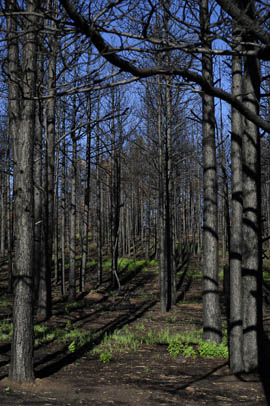Cronkite News has moved to a new home at cronkitenews.azpbs.org. Use this site to search archives from 2011 to May 2015. You can search the new site for current stories.
Federal study: ‘Intense’ forest thinning best way to ease catastrophic wildfires
WASHINGTON – It may have taken the largest wildfire in Arizona history, but for the first time in decades, environmentalists and government officials agree on a key element of future forest management.
The U.S. Forest Service said in a report this month that “intense thinning treatments” can ease future wildfires, by removing trees between 6 and 18 inches in diameter to allow for additional space between trees.
“Everyone agrees that a lot of the dry forest types need to be treated in terms of removing the vegetation,” said Morris Johnson, a research ecologist with the Forest Service and co-author of the report.
Intense thinning, according to the report, is reducing stands to leave 50 to 100 trees per acre. The study provides scientific grounds for continuing the practice of thinning heavily forested areas, showing that “the model and the reality match,” said Shaula Hedwall of the U.S. Fish and Wildlife Service.
Sandy Bahr, of the Grand Canyon chapter of the Sierra Club, agreed that thinning is an important part of forest management. But it should not be the only treatment, and does not apply to all forests.
“It’s not either-or in most cases,” Bahr said.
Bahr said that forest fires are a natural part of the ecosystem. Fires provide essential nutrients to the soil and remove trees that are difficult to otherwise thin.
Keeping forests healthy is a balance of thinning and other treatments, such as prescribed burning, she said.
Thinning was one of the treatments credited with saving some communities in the path of this summer’s record-breaking Wallow fire, officials said.
But Wally Covington, the director of the Ecological Restoration Institute at Northern Arizona University, said thinning is currently only used on thousands of acres in the state. Pointing to the size of this year’s blazes, thinning will need to cover hundreds of thousands of acres to be effective, he said.
“These big fires are making it obvious that we have to treat the entire land not just the little areas,” Covington said.
More than 890,000 acres in Arizona were charred in 2011, according to the federal government’s Incident Information System, which collects wildfire data from several agencies. The Wallow fire, covering 538,049 acres, was the largest in state history.
The Forest Service manages most of the land in Arizona. Management includes the removal of trees, which are sold to third-party companies, the proceeds of which help defray the cost of tree removal.
Bahr said that in the past groups have come to thin the state’s forests but have instead logged them. Since some machines used by loggers can only process old growth, the forests have been left less healthy and less fire-resistant.
Springerville Town Manager Steve West disagrees. He noted that some areas that were previously logged withstood the Wallow fire better than areas that were not.
West said that seeing different groups come to the table to work on future fire prevention gives him hope for the future.
“We won’t see major growth for the next 15 to 20 years, but at least our children will have the type of forest I grew up with,” said West, a lifelong Arizona resident.








